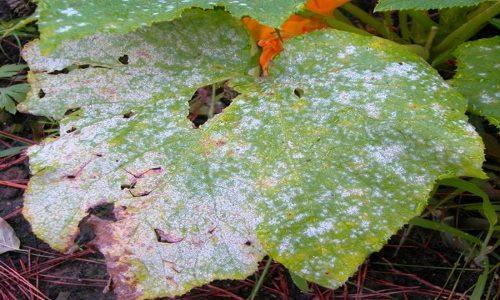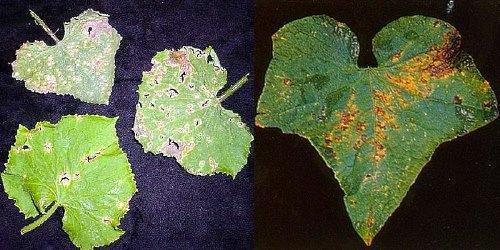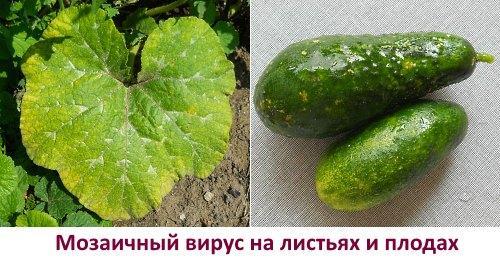Diseases of cucumbers and their treatment
To grow a rich harvest of cucumbers, it is necessary to know not only the peculiarities of the agricultural technology of this plant, but also diseases that can cause irreparable harm to the plant and destroy the entire crop.
Varieties of cucumber disease
Diseases that affect the cucumber liana at different stages of its growing season can be divided into three groups.
- Fungal diseases.
- Bacterial diseases.
- Viral diseases.
Fungal diseases of cucumbers
The most common fungal disease in cucumbers is powdery mildew. The reason for its appearance on the leaves is sudden changes in temperature, an excess of nitrogen in the soil or lack of potassium... Diseased plants are covered with white powder, stunted and gradually dry out.

Downy mildew or peronosporiosis occurs as a result of high humidity, when irrigated with cold water, a sharp drop in temperature. First, brown spots appear on the leaves, which dry out after a few days. Fungal spores remain on the back of the leaves. They are carried by wind and pests to neighboring areas. The disease arises from plant debris or seeds infected with the mycelium of the fungus. The disease is provoked by high humidity and cold watering, as well as sudden changes in day and night temperatures. It manifests itself during the fruiting period.
Dangerous fungal diseases of cucumbers should also include white rot, olive spot, root rot.
Bacterial diseases of cucumbers
The main signs of bacterial wilting (causative agent - Erwinia tracheiphila) are:
- sharp wilting of the plant;
- the appearance of a white sticky mass (similar to saliva), which is secreted from the stem;
- leaf spot and wilting.
The virus remains on the remains of the stem until next year. If signs of bacterial wilting are noticed, then all dry stems must be burned. Planting melons and gourds in this area is contraindicated for 5-6 years. Seeds harvested from such plants are also carriers of the disease.
Wet rot is caused by the bacterium Pseudomonas burgeri Pot. The source of infection is untreated infected seeds. The disease is often slow and begins to progress only with a decrease in air temperature. The owners complain about a bad variety or freshly harvested seeds, because the yield shortage in this disease can be 40%.
The first signs of wet rot:
- slow growth of shoots;
- wilting and drying of the lower leaves;
- a large number of barren flowers;
- the shape of the fruit is ugly;
- watery shell of the fruit and oil spots on the leaves;
- rapid loss of turgor at lunchtime;
- softening of stems and browning of blood vessels;
- brown mass inside the cucumber pulp.
Cucumber diseases spread very quickly in high humidity. Greenhouse plants suffer the most from this virus.
Angular leaf spot is the cause of the death of cucumbers in a short time and is considered the most dangerous disease, as it is quickly transmitted from one plant to another. The infection is spread by wind, water droplets, pests and infected seeds. The disease is characterized by the appearance of brown spots on the leaves and fruits, which dry out the tissue for several days. The bacterium multiplies most rapidly in warm, humid weather.

When damaged by vascular bacteriosis, the fruits lose their taste and marketability. They are unsuitable for food, as they become wooden.The infection spreads with the help of infected seeds and plant debris.
Cucumber viral diseases
For viral diseases of cucumbers, a change in leaf color is characteristic. Spots appear on it that resemble a mosaic, and the leaf blade itself curls and wrinkles. All viral diseases are seed or pest borne. Before planting, it is recommended to warm the seed at a temperature of +70 degrees for three days.

Cucumber mosaic appears 25-30 days after planting on young leaves. There is a spotty yellowing along the sheet, it is deformed. If you do not start fighting the disease, then in a few days the fruits will also become infected. The carrier of the cucumber mosaic is the aphid.

White mosaic on cucumbers appears as white and yellow star spots. Often the whole leaf turns white, and the fruits are painted in a white strip. It is possible to infect a plant with a white mosaic virus only by contact and seeds.
Green mosaic can be confused with a common fungal virus, but it only affects young leaves. Blister-like growths, mosaic yellowing, wrinkling appear on them. Plants grow poorly, the ovary dries and crumbles.
How to deal with fungal diseases of cucumbers?
The most successful fight against disease is the absence of disease. Preventive measures will help to achieve this result. What do we have to do?
- Follow crop rotation.
- Stick to regular watering with warm water.
- Loosen the soil.
In the fight against fungal diseases, spraying cucumbers with an infusion of mullein, marigolds has proven itself well.
In case of infection with powdery mildew, such drugs as "Topaz", "Kvdris" are excellent. "Oxyhom".
If the first signs of a disease with downy mildew are noticed, then it is necessary to stop fertilizing with mineral fertilizers and spray the plants with a solution of potassium permanganate, tincture of milk whey. In the acute phase, such drugs as "HOM", "Kuprosat", "Ridomil Gold", "Polycarbatsin" help. These preparations have an excellent effect in the fight against root and white rot, olive spot.
Ways to combat bacteriosis in cucumber disease
Bacterial diseases are the most common and every gardener needs to know the main rules for protecting plants from viruses of this group. Preventive work allows you to save young plants at the initial stage of their growing season.
- Pre-treatment of soil from painful bacteria.
- Disinfection of seeds before planting (soak for 12 hours in a dark solution of potassium permanganate).
- Regular weeding and removal of residues from the garden.
- Control of pests that carry infections.
- Proper watering of plants warm, settled water: you need to pour water into the furrows, and not under the root of the plant.
- Spraying cucumbers from pests.
- Observance of crop rotation: return the cucumbers to their place only four years after the melons.
- In the greenhouse, the appearance of bacterial diseases is directly related to the formation of condensation. To avoid a large amount of dripping moisture, during the period of temperature fluctuations, it is necessary to use space heating at night.
And if you failed to protect the plants from infection? How to treat cucumbers from diseases in order to preserve the harvest? Copper preparations will help: "Kuproksat", Bordeaux mixture. Processing must be carried out twice, with an interval of 10-12 days.
Fight against viral mosaic species
The best way to combat the viral mosaic is through prevention.
- Soak the seeds before planting in disinfectants or warm them up at a temperature of +70 degrees.
- Destroy all plant residues in the garden after harvest.
- Fight aphids and other insect pests.
- Disinfect consumables.
- Pour warm water into the furrows.
- Tie plants to a support.
- Monitor soil quality.
- Cull diseased plants.
These rules will help to avoid infection with a viral mosaic, but if the plant is sick, then you should not immediately resort to chemicals. Tinctures from onion scales, dandelion, tobacco, garlic will help to cope with the problem.
To know exactly which virus you are dealing with, you need the help of an agronomist. You can use the Internet or books on vegetable growing, which shows diseases of cucumbers in pictures and describes the characteristic signs of each type of infection and how to deal with them.
Video about cucumber diseases
https://www.youtube.com/watch?v=uzEViQFaO-U
I liked the article. But there is no time for the gardener to study the signs when the enemy is already on the doorstep. And the picture in reality is rarely classic. Usually only an agronomist can determine the signs.
There is only one way out, proper care. A healthy plant fights disease itself. Landing only in warm ground. Watering before fruiting is moderate. From time to time, dust the plants with ash, chalk, lime dusting. Watering only in the morning and always with warm water. In the evening after sunset, treatment with biologically active preparations is approximately the same as EM-1 Baikal. Such treatments destroy the few spores of fungal diseases, create protection against insects and diseases. There is no defense against viral diseases. Until the same aphid has transferred the virus to a healthy plant, the patient must be quickly destroyed at any stage of development. And try to remove vegetation and roots without touching neighboring bushes. A sign of the virus will be wilting, wrinkling of the leaves, a brown ring on the cut of the stem, the cucumber is tasteless and ugly. Wet rot can be avoided if the greenhouse does not have overnight condensation. It is especially important for prevention not to thicken the plants.
tell me what kind of rubbish on the leaves ??? and how to get rid of it ???
The best safe remedy for combating diseases of cucumbers during the fruiting period is iodine solution. Treatment should be carried out after every fog and rain. For 10 liters of water add 0.5 liters of milk and 15 - 30 drops of iodine. You can add 1 tbsp. l of liquid soap or shampoos for better adhesion. Cucumbers stop hurting and bear fruit well. The solution can be used for other vegetables as well.
what is it called and how to beard ???
What is this? Now there are normal plants, then suddenly, in a few hours. I sprayed it with iodine with milk and water, and phytosporin, and potassium permanganate. It's not that. I don't see aphids. Just to sprinkle intavir, just in case?
Judging by the appearance of the plant, it suffers from an overabundance of drugs. Simultaneous, or carried out with a short break, treatment with several drugs could provoke the appearance of burns on the leaves. So, dark spots on a leafy plate indicate an excess of the dose of potassium permanganate in the solution, and whitish blotches are the result of the action of iodine. Also inspect the potted soil for waterlogging. Too wet soil should be allowed to dry out, and if pests are found, the nutrient soil should be changed. As for the aphid, it lives on the back of the leaf, which is processed when a pest is detected.
Suddenly, overnight, the cucumber stalks wilted. It looked as if they were frozen. But inside the greenhouse + 12, outside + 8. The greenhouse is heated. They dug up the root, there is no rot, there are hematomas. Not all the stems wither, but after 5-6 from one bed ...
Please tell me what is with cucumbers. Leaves are curled and very light?
If the leaves of the plant are light, then there is not enough iron in the soil. Use Iron Chelate on the leaves.I really like the natural fertilizer Baikal-EM. The cost is low and the consumption is small, while it works wonders with the soil, enriching it with microorganisms and making it more nutritious. Plants grow better after watering and are less susceptible to disease.
Tell me what kind of disease it is and how does it fight